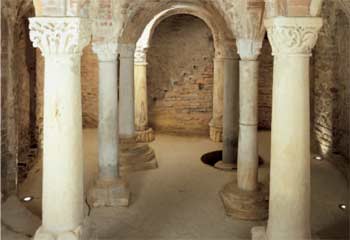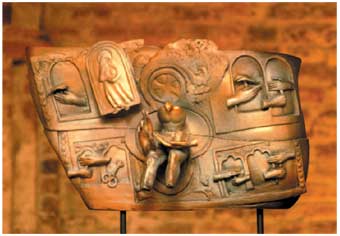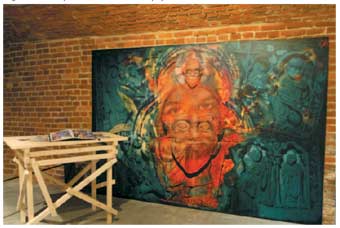
CRIPTA
E MUSEO DI SANT'ANASTASIO
Corso Alfieri 365/A
tel. 0141/437454
![]() critical text by Giulio Lucente
critical text by Giulio Lucente
Even if Even if Emiliano Alfieri and Diego Zangirolami did not consult before creating their works, they turned out to be in tune with each other as far as the expressive line is concerned, though they are characterised by opposed guiding principles.Alfieri analysed the frontal, its historical context and its symbolic meaning. He studied its composition, resolving it into its components and then focused his attention on the rhythmical play of the saints' hands and particularly of Christ's hands. He has driven the analysis of the components to its extremes, offering them back to the viewers' eye in a contemporary shape with a refined sculptural evolution, which enhances the volumetric potential of a work that was conceived as flat and turns it into a piece with soft and sinuous volumes and forms.On the contrary, Zangirolami reinterprets from an archaic point of view a typically contemporary concept, the icon of success, the ephemeral myth, which a certain popular and populistic culture seems to be fond of. He sets the figure of the football player or the movie star beside what could or rather should be the medieval inspiring model: the knight, the saint, the martyr. With a clever use of computer graphics, he creates a “sticker album” which he leaves on a table for whoever wants to flip through it, comparing the values of the time to those that we have elevated to the rank of modern icons, judging which ones are more uplifting.The room also houses a large panel (elaborated with a computer) that works as a big fresco, always following the line of turning the ancient works into contemporary art with the help of techniques that are not necessarily traditional. In the end, these artists' work cannot be inscribed within a perspective of reprise or d'apres , but within a contemporary path leading unequivocally to the creation of a work of art using the tools we have at our disposal and a forma mentis constantly evolving towards the creation of works of art which are creatures of our times.


